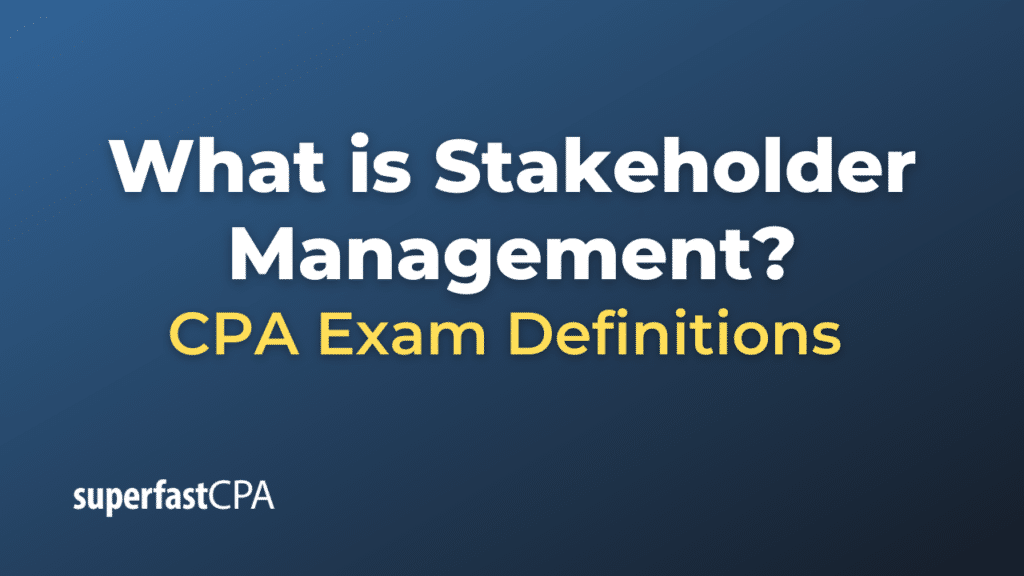Stakeholder Management
Stakeholder management refers to the systematic identification, analysis, planning, and implementation of actions designed to engage with stakeholders. It’s an integral part of project management and organizational strategy, ensuring that stakeholders are aware of, aligned with, and supportive of the objectives, decisions, and activities of a project or organization.
Effective stakeholder management helps in building strong relationships, reducing and managing risks, gaining support, addressing concerns, and ultimately ensuring the success of projects and organizational initiatives. The process generally involves the following steps:
- Identification: Determining who the stakeholders are. This involves listing all potential individuals, groups, or institutions that have an interest in the project or can influence or be influenced by its outcome.
- Analysis: Understanding the stakeholders in detail.
- Interest: What interest does the stakeholder have in the project? Are they supportive, neutral, or resistant?
- Influence: How much power does the stakeholder have to facilitate or hinder the project?
- Needs and Expectations: What are the stakeholder’s main concerns, needs, and expectations from the project?
- Prioritization: Based on the analysis, stakeholders are often prioritized to determine who needs more focused attention. This can be based on a matrix of their level of interest and influence. Key stakeholders usually have high interest and high influence.
- Engagement Strategy : Developing a plan on how to communicate and interact with each stakeholder or group of stakeholders.
- Communication Plan: Deciding what, when, and how to communicate with stakeholders. This includes selecting the right communication channels, frequency, and content.
- Relationship Building: Taking actions to build trust and rapport with stakeholders, especially those critical to the project’s success.
- Implementation: Putting the engagement strategy into action. This involves regular communication, addressing concerns, gathering feedback, and adjusting the approach as necessary.
- Review and Adjust: Continuously monitoring and adjusting the stakeholder management strategy. Stakeholder dynamics can change as a project progresses, so it’s essential to remain flexible and adaptive.
Effective stakeholder management provides numerous benefits, such as:
- Support and Resources: By aligning stakeholders with project objectives, they are more likely to provide support and resources when needed.
- Risk Mitigation : By understanding and addressing stakeholder concerns, potential risks can be identified and mitigated early.
- Feedback Loop: Regular engagement provides an avenue for constructive feedback, helping in continuous improvement.
- Enhanced Reputation: Positive stakeholder relationships enhance the reputation of the organization or project in the broader community or industry.
Remember, stakeholder management is not a one-time activity. It’s a continuous process that evolves as the project or initiative progresses.
Example of Stakeholder Management
Let’s delve into a hypothetical example to illustrate stakeholder management in practice.
Scenario: A city council plans to construct a public park in an urban area that lacks green spaces.
1. Identification: Potential stakeholders include:
- Local residents
- Local businesses
- Environmental activists
- The city’s planning and development department
- Contractors and suppliers for the park construction
- Nearby schools
- Local wildlife and conservation groups
- Local media outlets
2. Analysis:
- Local Residents: High interest (they’ll use the park), High influence (their support is crucial).
- Local Businesses: Moderate interest (potential increased patronage), Low influence.
- Environmental Activists: High interest (environmental concerns), Moderate influence (can rally public opinion). … and so on for each stakeholder.
3. Prioritization: Given the analysis, the city council decides to prioritize engagement with local residents, the planning and development department, and environmental activists, considering their high interest and influence.
4. Engagement Strategy:
- Local Residents: Organize town hall meetings to discuss park designs, gather feedback, and address concerns. Also, share updates through a dedicated website and periodic newsletters.
- Environmental Activists: Collaborate early on to ensure environmentally-friendly park designs and to identify potential ecological impact.
- Planning and Development Department: Regular meetings to ensure that all permits, regulations, and standards are met. … and tailored engagement strategies for other stakeholders.
5. Implementation:
- The city council holds the first town hall meeting, sharing initial designs and gathering feedback.
- A working group, including some environmental activists, is set up to advise on the park’s ecological aspect.
- Regular check-ins with the planning and development department ensure that the project is on track concerning regulatory standards.
6. Review and Adjust: After a few months, feedback from local schools indicates a desire for a safe play area for children. The city council revises the park design to incorporate this. Also, based on concerns from a local wildlife group, certain tree species are chosen to support local birds.
Over time, thanks to effective stakeholder management:
- The park design is refined to be more inclusive and environmentally sustainable.
- Potential delays due to regulatory hurdles are minimized through early and regular engagement with the planning department.
- The project enjoys broad support from the community, ensuring smooth progress and widespread use once the park is inaugurated.
This example showcases how stakeholder management is not just about informing stakeholders but actively engaging them, addressing their concerns, and adjusting plans based on their feedback for better outcomes.













